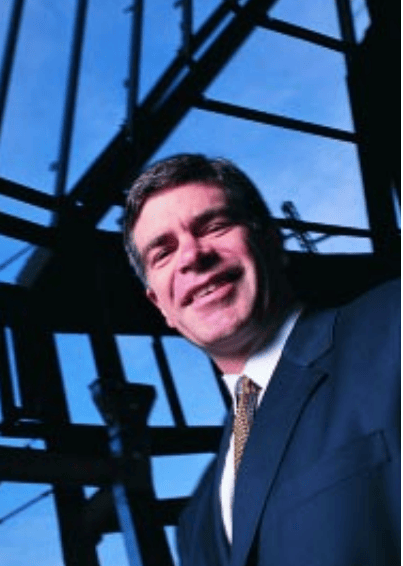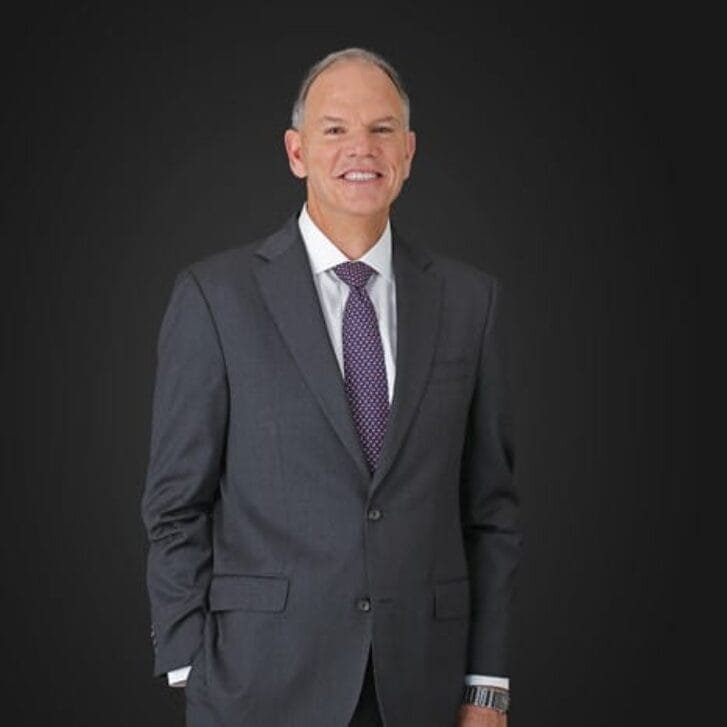August 2002 will mark an important milestone in the history of the Wharton School. For the first time, we will have a true home that brings together the entire Wharton community – students, faculty, and alumni. A home that transforms the campus environment and reaches out to the global community – not merely as a symbol of our leadership, but also as the very laboratory of innovation that defines our leadership.
Located along 38th Street, between Walnut Street and Locust Walk, Jon M. Huntsman Hall promises great things for the Wharton School. And when it opens next summer, it will deliver.
Imagine this: a 320,000-square-foot building, in which 5,000 undergraduate, MBA, and doctoral students, 250 faculty, and visiting alumni and executives interact daily within 48 flexible, technologically equipped classrooms, four computer labs, 57 group study rooms, four floors of faculty offices, cafes, common spaces, and pedestrian walkways.
Or imagine this: 500 alumni gather for a reunion celebration in the Forum, a two-story atrium that by day serves as a student lounge and gathering place. On the eighth floor colloquium level, faculty from several distinguished universities meet in person and with scholars around the world via satellite link to share research findings and create new knowledge to fuel business practice. At the same time, the 300-seat auditorium hosts a panel discussion of international business leaders, policymakers, and students as part of one of our 12 annual student organized conferences.
In Huntsman Hall, these will be daily realities.
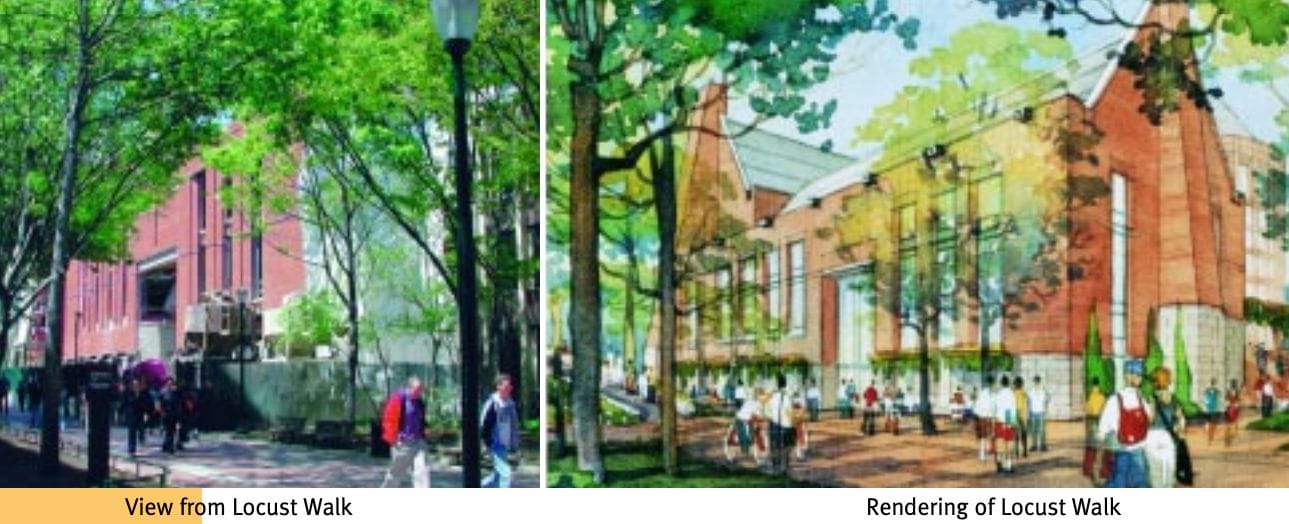
Reinventing the Learning Environment
Wharton’s history and spirit of relentless innovation and invention have been the driving force in creating the need for Huntsman Hall. In achieving the unsurpassed international reputation we currently enjoy, we have instituted revolutionary changes in business education. But at the same time, our current buildings, dating back to the early 1950s and 1970s, haven’t kept pace with these programmatic transformations. Ask any current or recent students or professors. They will describe the very real need for space at the School, the kind of space that supports and invigorates a 21st century community of learners.
■ We’ve grown our faculty, adding unparalleled depth across disciplines. But office space is so scarce that many professors cannot meet with students for office hours or the informal conversations that so deeply enrich the educational process outside the classroom.
■ We have also created new learning models that have forever changed the face of business education. With a stronger emphasis and strengthening of the core curricula at both the MBA and undergraduate levels, students move through their coursework in larger groups – sometimes 75 to 80 students per class, a capacity that few of our classrooms can accommodate. And team-meeting space, essential to the team-learning curricular approach that has won Wharton’s programs high praise by recruiters around the world, is nearly absent in our existing facilities. Without it, students work wherever they can, often in their dorms or off-campus housing without vital technology connections. Many students simply resort to holding project sessions in hallways, where they must sit on the floor – blocking traffic and dealing with constant interruptions that impede productive work.
■ A central ingredient in our commitment to continued curricular innovation is the integration of new learning technologies throughout the School. Through the Alfred West, Jr. Learning Lab professors are creating new technology tools for use in their courses. Market simulators that allow instructors to manipulate variables, for example, turn the classroom into a trading floor for hands-on learning. Technology has completely transformed our approach to learning, but our current classrooms are inadequate to take full advantage of these advances.
Our success to this point has been in our ability to manage our resources as creatively as possible. An analysis that compared our facilities to other top-tier business schools revealed that we lagged behind our peers, many of whom had invested in new facilities. In fact, we discovered that we had less academic space per student than the average U.S. public high school! We’ve been able to do more with less, but we still struggle to match the quality of our programs to an environment that will spur further growth and innovation.
As the recognized global leader in business education, we need a home base that reflects our excellence and promotes our aspirations. As the single largest addition of academic space on Penn’s campus since World War II, Huntsman Hall will provide the facilities that will walk in step with our vision.
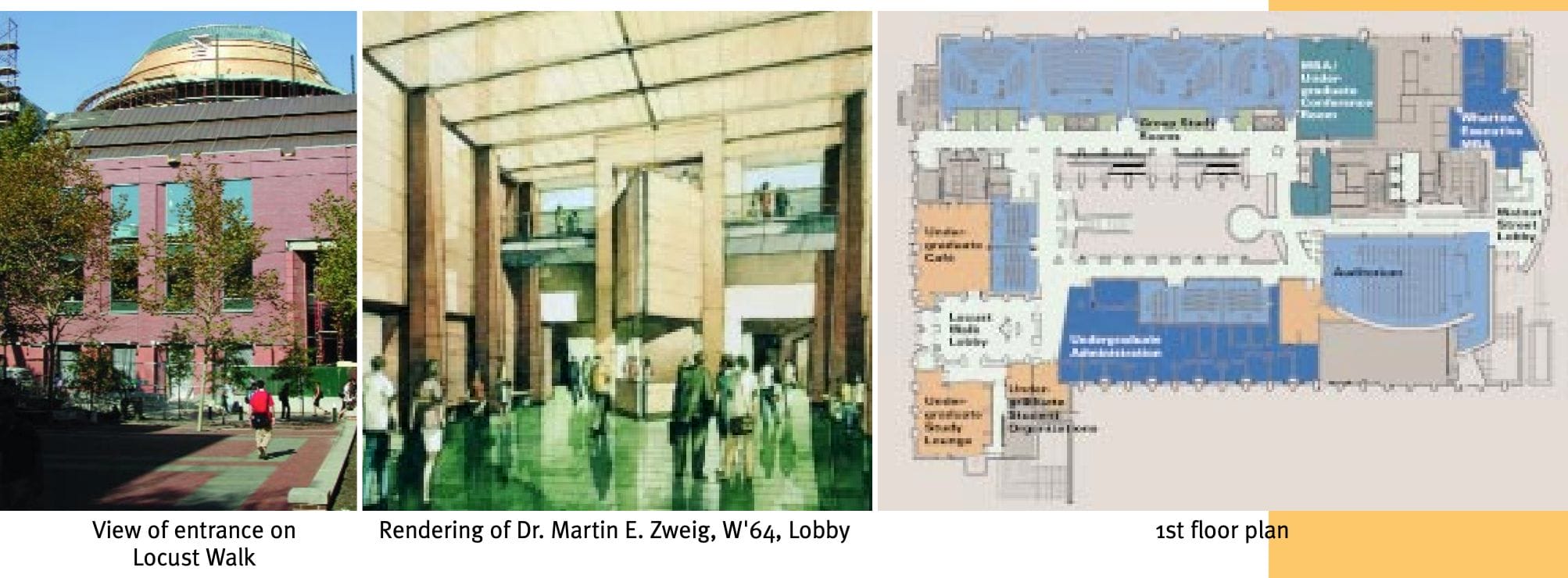
Huntsman Hall: The Catalyst for Leadership
Wharton’s unique energy comes from bringing together the world’s best students with the world’s best business faculty. The School’s leadership will be greatly strengthened by having the world’s finest academic environment in which these elements merge. Huntsman Hall’s compelling spaces and the dynamic intellectual exchanges they will ignite will confirm the essential character of our leadership: passion for excellence and innovation in advancing the study and practice of global business.
Huntsman Hall will be our new home – a home in which students and faculty can engage each other, and from which they can converse with the world. Located on the main thoroughfare of campus, Huntsman Hall will not only be the center of Wharton’s learning community, but will also ensure that Wharton remains at the center of Penn’s vibrant academic enterprise.
Creating this facility, which is the very manifestation of our future, is fundamental to our success as the global leader in management education – a home that reflects the School’s excellence and enables the entire Wharton community to set new standards in business leadership
The Foundation for Future Generations
Huntsman Hall is the cornerstone of Wharton’s Campaign for Sustained Leadership. In a bold move, we set as our goal that Huntsman Hall would be funded entirely by the generosity of the Wharton community. With a leadership gift from alumnus and Board of Overseers Chairman Jon M. Huntsman, W’59, we are well on the way to achieving this critical objective. But we are not through. I ask you to consider assisting us in completing this effort. I invite you to explore naming-level gift opportunities still available for many of the building’s most significant spaces.
Just as Huntsman Hall will provide the physical infrastructure from which we will continue our proud history of leadership, we must also support the programmatic and scholarly initiatives of the School. Endowment for faculty support, student aid, and academic programming, as well as the Wharton Fund, are crucial goals of the Campaign for Sustained Leadership. We must lay the foundation of financial strength for future generations. Our ultimate success depends on everyone giving back – in gratitude to the school that launched our own individual and personal success. This is our responsibility and our legacy.
I hope you’ll join me as we build our new home and provide the support for our next century of leadership.
Pat Harker, Dean

Building for the Future: The Wharton Campus
- 1881: The Wharton School was Established in College Hall.
- 1904: The School moved to Logan Hall.
- 1952: The School relocated to Dietrich Hall, the first true Wharton building.
- 1972: Opened Vance Hall to house Wharton’s Graduate Division.
- 1983: Moved into refurbished and expanded Steinberg Hall- Dietrich Hall.
- 1987: Opened the Steinberg Conference Center, a state of the art education facility to house the Aresty Institute of Executive Education.
- 1990: Dedicated the Lauder-Fischer Hall, the home of the Lauder institute and the Wharton Real Estate Development and Center.
- October 2001: Opened Wharton West in the historic Folger Building located in San Francisco. The Folger Building will provide space for executive education programs, faculty members conducting research on the West Coast, and for MBA courses for Philadelphia-based students.
- Fall 2002: Will open Huntsman Hall, the most advanced facility for management education and one of the first of such facilities to be entirely funded by alumni support.
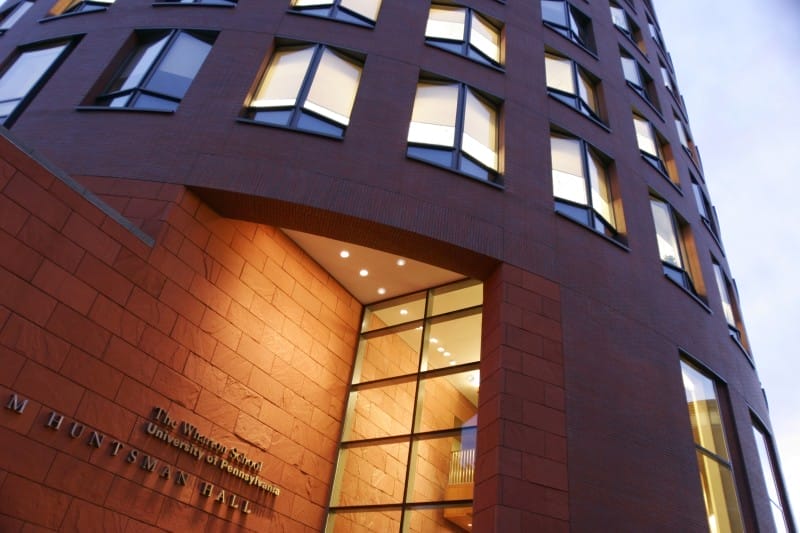
From the Wharton Community
MATT GREENE, WG’89, Managing Director, Utendahl Capital Partners: “I can see my gift helps to make a difference in a very concrete way. I had never been exposed to the opportunity to help make such a tangible difference. We needed a new building. You can actually visit it and see what you’ve helped to make happen. You can see that you’re part of something.”
SHIMIKA WILDER, W’04: “I think that it will create a stronger sense of community that will undoubtedly foster our development as business leaders.”
MICHAEL USEEM, the William and Jacalyn Egan Professor and Professor of Management: “The quality of the classroom learning experience depends on the quality of the classroom itself, and the state-of-the-art rooms in Huntsman Hall are sure to take the Wharton educational experience to a new level of engagement and intensity.”
DAVID J. REIBSTEIN, William Stewart Woodside Professor and Professor of Marketing: “Today’s teaching demands the use of multimedia technology, which will be greatly facilitated by the new Wharton building. It will not only help communicate that we have entered the 21st century, but will allow us to enhance the quality of content and increase the level of student engagement.”
LEIGH WAYBURN, WG’02, Vice President, WGA: “Huntsman Hall gives us a forum to build upon an atmosphere of leadership and strengthens our community as well.”
JENNIFER P. BERNSTEIN, WG’03: “Huntsman Hall is an incredible addition to the Wharton School. Wharton is a preeminent business school. I feel it is time that we have world-class facilities to equal our name.”
KHADIR N. RICHIE, WG’02, WGA President: “Huntsman Hall will solidify the strong community and culture that we are currently building. It will give the students and administration the opportunity to proactively shape the culture that we want to have going forward. Students will be able to call Huntsman Hall their ‘home.’”
BETH NELSON, WG’82, Principal, Neuberger & Berman Llc: “For Wharton to continue to excel in a global arena, all alumni – including those of us from the Executive MBA program – must return something to the School.”
RON ROSENFELD, W’61, President, Government National Mortgage Association: “If we want to maintain our preeminence, it takes resources. Many of our physical assets on campus have depreciated, and we have many competitors. If we are going to stay number one, we need to invest in the future.”




















